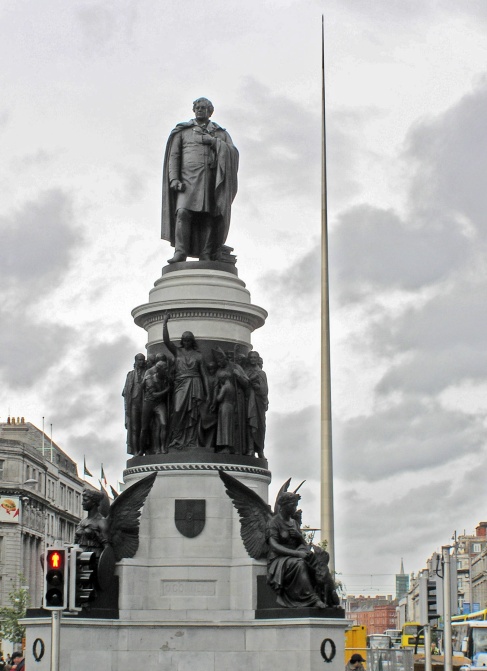County Clare
Parish of Inagh
This parish and adjacent lands are the home territory of the Gaelic ancestors of present-day Irish Crowes. The village of Inagh is just 13 minutes west of Ennis on N85 by car, or 22 minutes by bus which runs every 2 hours. The townland named Skaghvickincrow (‘Crowe’s thornbush’) is in the parish. Have lunch in the village and perhaps pick up some local insights. See the stone with an inscription in Ogham characters near the remnants of Bothneil castle.
Nutfield (otherwise Dromconora) and Dromore
Dromconora House, the residence of various Crowe families from mid-1700s to the early 19th century, was located here. Unfortunately the country house is long gone, but you can at least get an idea of the beauty of the area in which they lived. The Nutfield (Dromconora) Bridge nearby spans the River Fergus. An archaeological survey reports that a plaque from the original structure was incorporated in the southern parapet: “Although worn, this plaque, dated 1663, records the patrons and overseers responsible for the original construction’. However, a recent search failed to locate the plaque.

Nutfield Bridge, Co Clare.
Nutfield is just 9 minutes north of Ennis by car on R458. A further 5 minutes north is the village of Ruan.
A further 4 minutes to the west will take you to Dromore Woods and Dromore Lake. Dromore House was located in this area; unfortunately it too has been demolished. The house was the residence of Thomas Crowe (1803-1877) and Charlotte Isabelle Forster Hume (Bef.1809-1907) and their ten children. He was High Sheriff and later Deputy Lieutenant of County Clare.
Also to be found there are the ruins of Dromore Castle overlooking Dromore Lake. The castle was in the hands of the O’Briens in the 16th and 17th centuries. It is classified as a National Monument.
Staff at the Ruan Library may be able to give you more information about the area and its history
Kilrush
The Campbelltown Pioneer Register 1800–1900 has it that the William Crowe who came to Australia in 1813 was born in Kilrush. However, this has turned out not to be the case. However, there is a connection there with Crowe family history. Kilrush was the place of birth of Ellen Tymons, wife of Thomas Crowe (1777-1855) of Abbeyfield House in Ennis. The town is 38 minutes south of Ennis on N68.
Here is Market Square, Kilrush late one evening. Just off camera to the right is Crotty’s Bar – famous for traditional Irish music and good fun generally.

Market Square, Kilrush, Co Clare.
Dublin
Daniel O’Connell statue
A grand statue of ‘The Liberator’ by the famous sculptor of the Victorian era John Henry Foley is on O’Connell Street at the River Liffey end. Foley Street in Dublin is named after the sculptor.

Daniel O’Connell monument, Dublin. Image is an open access image taken from Daniel O’Connell’s Wikipedia page.
Trinity College Dublin
A 10-minute walk from the O’Connell monument over O’Connell Bridge takes you to the university attended by four members of the Ennis Crowes: Thomas Crowe of Dromore was admitted in 1820, John Crowe in 1822, William Crowe in 1830 and Wainwright Crowe in 1836. All were aged 17 on admission except Wainwright Crowe who was 19.

The Long Room, Trinity College, Dublin. Image by Jonathan Singer accessed from the website Unsplash
The above mentioned John Crowe was the benefactor who left a legacy to James Crowe (1820-1889) of Gobarralong, NSW.
College Green
It was here that George Crowe (1750-1808) was killed in a duel. It is now a busy roadway with Trinity College on one side and the Bank of Ireland on another. Prior to the Act of Union of 1800, the Bank of Ireland building was the Irish House of Parliament. George Crowe’s brother Robert Crowe (1745-1817) was an MP in 1798-1799.
St Kevin’s Park
About a further 15-minute walk from College Green brings you to St Kevin’s Park (formerly St. Kevin’s Old Churchyard) on Camden Row.

St Kevin’s Park, Dublin
The route from College Green takes you along Aungier Street where James Crowe (1712-1774) and family lived in the latter part of the 18th century. St Kevin’s was a ‘chapel of ease’ for the main parish church, St. Peter’s at 53 Aungier Street. St Peter’s was demolished in 1983 and replaced by a YMCA building. The Crowe family probably lived at the end of Aungier Street closer to St Kevin’s.
James Crowe, his daughter Elizabeth (1760-1794) and her husband William Fleming (1747-1795) are buried here. Some of the gravestones have been re-located around the perimeter of the park; others behind a locked gate are in the interior of the ruined church building. The one remaining gravestone is for the Moore family, parents of the famous poet and lyricist Thomas Moore. The Crowe grave was just 4 metres distant, and still is if the Moore grave was not relocated when the park was landscaped.